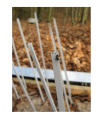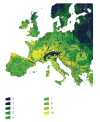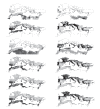Effects of climate change on ticks and tick-borne diseases in europe
- PMID: 19277106
- PMCID: PMC2648658
- DOI: 10.1155/2009/593232
Effects of climate change on ticks and tick-borne diseases in europe
Abstract
Zoonotic tick-borne diseases are an increasing health burden in Europe and there is speculation that this is partly due to climate change affecting vector biology and disease transmission. Data on the vector tick Ixodes ricinus suggest that an extension of its northern and altitude range has been accompanied by an increased prevalence of tick-borne encephalitis. Climate change may also be partly responsible for the change in distribution of Dermacentor reticulatus. Increased winter activity of I. ricinus is probably due to warmer winters and a retrospective study suggests that hotter summers will change the dynamics and pattern of seasonal activity, resulting in the bulk of the tick population becoming active in the latter part of the year. Climate suitability models predict that eight important tick species are likely to establish more northern permanent populations in a climate-warming scenario. However, the complex ecology and epidemiology of such tick-borne diseases as Lyme borreliosis and tick-borne encephalitis make it difficult to implicate climate change as the main cause of their increasing prevalence. Climate change models are required that take account of the dynamic biological processes involved in vector abundance and pathogen transmission in order to predict future tick-borne disease scenarios.
Figures





References
-
- Randolph SE. Evidence that climate change has caused ‘emergence’ of tick-borne diseases in Europe? International Journal of Medical Microbiology. 2004;293(supplement 37):5–15. - PubMed
-
- Gray JS. The development and seasonal activity of the tick Ixodes ricinus: a vector of Lyme borreliosis. Review of Medical and Veterinary Entomology. 1991;79(6):323–333.
-
- Christensen JH, Hewitson B, Busuioc A, et al. Regional climate projections. In: Solomon S, Qin D, Manning M, et al., editors. Climate Change 2007: The Physical Science Basis. Contribution of Working Group 1 to the Fourth Assessment Report of the Intergovernmental Panel on Climate Change. Cambridge, UK: Cambridge University Press; 2007. pp. 847–940.
-
- Fischlin A, Midgley GF, Price JT. Ecosystems, their properties, goods, and services. In: Parry ML, Canziani OF, Palutikof JP, van der Linden PJ, Hanson CE, editors. Climate Change 2007: Impacts, Adaptation and Vulnerability. Contribution of Working Group II to the Fourth Assessment Report of the Intergovernmental Panel on Climate Change. Cambridge, UK: Cambridge University Press; 2007. pp. 211–272.
LinkOut - more resources
Full Text Sources
Other Literature Sources

